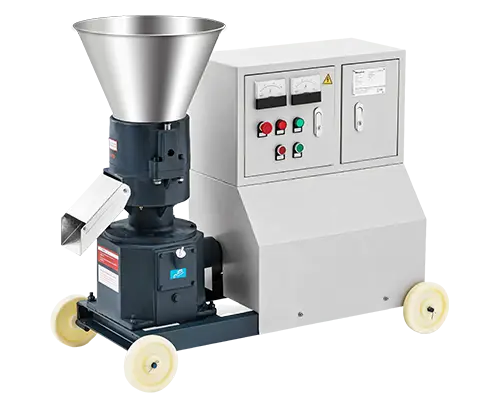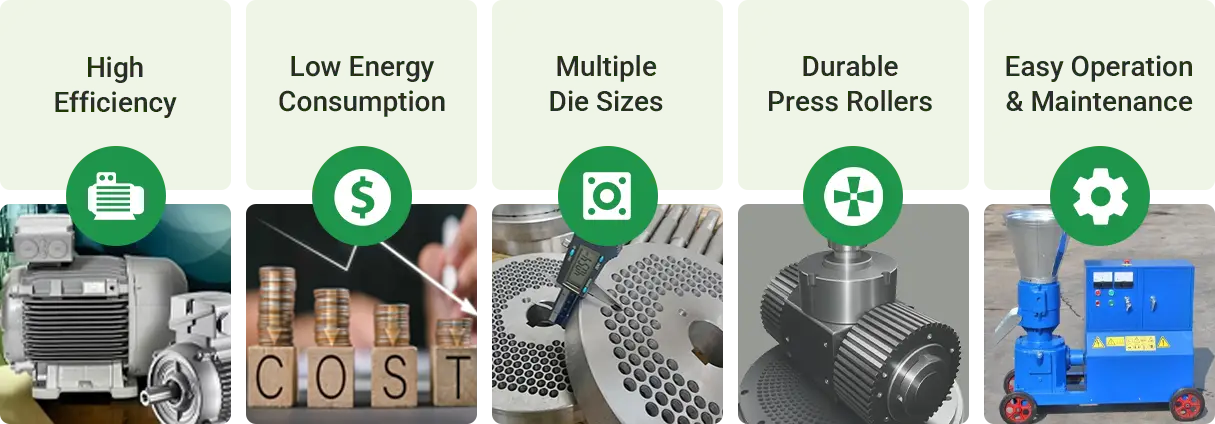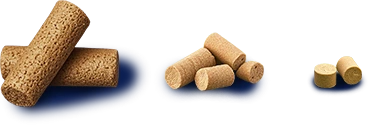Kawise straw pellet mill is suitable for processing wheat straw, corn stalks, rice straw, and various other raw materials. It ensures stable production and a high pelletizing rate, making it an ideal solution for biomass energy production and agricultural waste utilization.

- Eco-Friendly: Releases 15x less sulfur dioxide than coal, cutting air pollution.
- Livestock Bedding: Highly absorbent, keeping animals dry and reducing disease risk.
- High Density & Storage: Volume shrinks 9x, density 1100 kg/m³, lowering transport costs.
- Versatile Use: Ideal for heating stoves, biomass boilers, and industrial power, replacing coal economically.

Kawise’s Straw Pellet Mill for Sale
| Model | Power (kw) | Capacity(kg/h) | Roller | Die Hole (mm) |
| KD-160 | 4.5 | 130-180 | 3 | 2.5-8 |
| KD-210 | 4.5 | 200-300 | 2 or 3 | 2.5-8 |
| KD-230 | 11 | 250-400 | 3 | 2.5-8 |
| KD-260 | 15 | 300-500 | 3 or 4 | 2.5-8 |
| KD-300 | 22 | 500-700 | 4 | 2.5-8 |
| KD-400 | 37 | 900-1200 | 4 | 2.5-8 |
How to Choose the Right Model
- For small-scale production (households or small farms): Choose KD-210 or KD-230.
- For medium-scale production (cooperatives, small factories): Choose KD-260 or KD-300.
- For large-scale production (biomass fuel factories): Choose KD-400, with a capacity of up to 1200 kg/h.
Choosing the Right Pellet Size & Die
- For home heating, cooking, or farm heating: Best diameter 6mm.
- For large livestock bedding (cattle, horses): Best diameter 8-10mm.
- For small pet bedding (rabbits, guinea pigs): Best diameter 3-5mm.
- For pig bedding: Best diameter 6-8mm.
- For poultry bedding (chickens, ducks): Best diameter 4-6mm.
- For industrial applications: Best diameter 8-10mm.

Key Features of the Straw Pelletizer
- High Efficiency: Equipped with a powerful motor for stable and high pelletizing rates.
- Low Energy Consumption: Optimized for lower production costs.
- Multiple Die Sizes: Supports 2.5-8mm hole diameters to accommodate various uses (fuel pellets, bedding).
- Durable Press Rollers: Made from high-strength wear-resistant alloy, ensuring a longer lifespan.
- Easy Operation & Maintenance: Modular structure allows for quick disassembly and cleaning.
Corn Stalk Pellets – Technical Specifications
| Parameter | Data Range |
| Lower Heating Value (LHV) | 16-18 MJ/kg (≈3,800-4,300 kcal/kg) |
| Higher Heating Value (HHV) | 17-19 MJ/kg (≈4,000-4,500 kcal/kg) |
| Pellet Size | Diameter: 6-12mm, Length: 10-25mm |
| Color | Light brown or yellowish-brown (depends on drying process) |
| Density | 1.1-1.3 g/cm³ |
Rice Straw Pellet – Technical Specifications
| Parameter | Data Range |
| Lower Heating Value (LHV) | 12-15 MJ/kg (≈2,870-3,580 kcal/kg) |
| Higher Heating Value (HHV) | 13-16 MJ/kg (≈3,110-3,820 kcal/kg) |
| Pellet Size | Diameter: 6-10mm, Length: 10-30mm |
| Color | Light yellow to light brown, depending on material & processing |
| Density | 1.1-1.3 g/cm³ |
Wheat Straw Pellet – Technical Specifications
| Parameter | Data Range |
| Lower Heating Value (LHV) | 14-16 MJ/kg (≈3,350-3,820 kcal/kg) |
| Higher Heating Value (HHV) | 15-17 MJ/kg (≈3,580-4,060 kcal/kg) |
| Pellet Size | Diameter: 6-10mm, Length: 10-30mm |
| Color | Light yellow to light brown, depending on processing method |
| Density | 1.1-1.3 g/cm³ |

FAQs – Common Customer Questions
Q1: Are straw pellets as good as wood pellets?
A1: Straw pellets break down faster, making them ideal for composting. They also absorb moisture well but have a darker color, which some users find less visually appealing.
Wood pellets decompose slower, provide a cleaner and brighter bedding appearance, and are less likely to be mistaken for food.
Straw pellets are more environmentally friendly for those prioritizing biodegradability and absorbency, while wood pellets offer better aesthetics and stability.
Q2: Do horses eat straw pellet bedding?
A2: Horses in traditional stables often chew loose straw, leading to weight gain. However, most horses do not eat straw pellets, and even if they try, they usually find them unpalatable once crushed.
To prevent accidental ingestion, soak the pellets before use, allowing them to expand three times their dry volume, creating a soft, absorbent bedding. This method also enhances urine absorption while reducing the likelihood of horses consuming them.
Q3: Can you burn straw pellets in a pellet stove?
A3: Burning straw pellets in older pellet stoves can cause higher ash content, increased dust emissions, and more slag buildup.
While traditional wood pellet stoves may struggle with straw pellets, modern biomass pellet stoves are designed to handle them efficiently. Always check your stove’s specifications before switching fuels.
If you need a straw pellet mill for sale, Kawise offers:
- Advanced Straw Pellet Press Technology – Precision engineering for stable production.
- Efficient Rice Straw Pellet Making Machines – Convert waste into value.
- Reliable Straw Pelletizers – High output, low maintenance, and cost-effective operation.
Contact us today to learn more about our straw pellet mill solutions!






